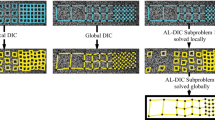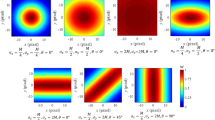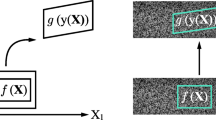Abstract
Background
Digital Image Correlation (DIC) is a widely employed full-field measurement technique in the realm of experimental mechanics. Nevertheless, mitigating measurement errors, particularly in fields with large strain gradients, remains a challenge.
Objective
The Gaussian window is employed to weight the correlation criterion in order to enhance measurement accuracy, and this method is called Gaussian window weighted DIC (GW-DIC). However, the optimization of the weighted correlation criterion does not guarantee that the displacement vector iterates to its optimal solution as the Gaussian window parameter changes during the iteration.
Methods
A new power window and the power window weighted DIC (PW-DIC) are proposed. The parameters of this power window keep constant during the iteration, and can be selected by given self-adaptive strategy for accuracy or preset according to the presumed deformation of the region of interest (ROI) for efficiency.
Results
The calculation example of synthetic images with imposed homogeneous deformation indicates that, the proposed power window is more effective than the Gaussian window when weighting the correlation criterion. For multi-directional deformation fields, both the displacement and strain accuracy of PW-DIC with self-adaptive parameters are at least 18% superior to those of conventional DIC. The tensile experimental dataset indicates that PW-DIC is more accurate and stable than GW-DIC.
Conclusions
PW-DIC with self-adaptive parameters is better suited for strain measurement in fields with large strain gradients. The weighted correlation criterion with preset parameters can potentially serve as a substitute for conventional correlation criterion.
















Similar content being viewed by others
References
Yamaguchi I (1981) Speckle displacement and decorrelation in the diffraction and image fields for small object deformation. Opt Acta (Lond) 28:1359–1376. https://doi.org/10.1080/713820454
Peters WH, Ranson WF (1982) Digital imaging techniques in experimental stress analysis. Opt Eng 21:427–431. https://doi.org/10.1117/12.7972925
Pan B, Li K, Tong W (2013) Fast, robust and Accurate Digital image correlation calculation without redundant computations. Exp Mech 53:1277–1289. https://doi.org/10.1007/s11340-013-9717-6
Chen B, Jungstedt E (2022) Fast and large-converge-radius inverse compositional Levenberg–Marquardt algorithm for digital image correlation: principle, validation, and open-source toolbox. Opt Lasers Eng 151:106930. https://doi.org/10.1016/j.optlaseng.2021.106930
Luu L, Wang Z, Vo M et al (2011) Accuracy enhancement of digital image correlation with B-spline interpolation. Opt Lett 36:3070. https://doi.org/10.1364/ol.36.003070
Tong W (2005) An evaluation of digital image correlation criteria for strain mapping applications. Strain 41:167–175. https://doi.org/10.1111/j.1475-1305.2005.00227.x
Boukhtache S, Abdelouahab K, Berry F et al (2021) When deep learning meets digital image correlation. Opt Lasers Eng 136:106308. https://doi.org/10.1016/j.optlaseng.2020.106308
Yu L, Pan B (2017) Single-camera high-speed stereo-digital image correlation for full-field vibration measurement. Mech Syst Signal Process 94:374–383. https://doi.org/10.1016/j.ymssp.2017.03.008
Zaletelj K, Agrež V, Slavič J et al (2021) Laser-light speckle formation for deflection-shape identification using digital image correlation. Mech Syst Signal Process 161:107899. https://doi.org/10.1016/j.ymssp.2021.107899
Huang J, Zhou K, Chen W, Song H (2021) A pre-processing method for digital image correlation on rotating structures. Mech Syst Signal Process 152:107494. https://doi.org/10.1016/j.ymssp.2020.107494
Wang B, Pan B (2015) Random errors in digital image correlation due to matched or overmatched shape functions. Exp Mech 55:1717–1727. https://doi.org/10.1007/s11340-015-0080-7
Schreier HW, Braasch JR, Sutton MA (2000) Systematic errors in digital image correlation caused by intensity interpolation. Opt Eng 39:2915–2921
Bornert M, Brémand F, Doumalin P et al (2009) Assessment of digital image correlation measurement errors: methodology and results. Exp Mech 49:353–370. https://doi.org/10.1007/s11340-008-9204-7
Pan B (2009) Reliability-guided digital image correlation for image deformation measurement. Appl Opt 48:1535–1542. https://doi.org/10.1364/AO.48.001535
Yang J, Bhattacharya K (2019) Augmented Lagrangian digital image correlation. Exp Mech 59:187–205. https://doi.org/10.1007/s11340-018-00457-0
Pan B, Asundi A, Xie H, Gao J (2009) Digital image correlation using iterative least squares and pointwise least squares for displacement field and strain field measurements. Opt Lasers Eng 47:865–874. https://doi.org/10.1016/j.optlaseng.2008.10.014
Wang B, Pan B (2019) Self-adaptive digital volume correlation for unknown deformation Fields. Exp Mech 59:149–162. https://doi.org/10.1007/s11340-018-00455-2
Huang J, Pan X, Peng X et al (2013) Digital image correlation with self-adaptive Gaussian windows. Exp Mech 53:505–512. https://doi.org/10.1007/s11340-012-9639-8
Yuan Y, Huang J, Peng X et al (2014) Accurate displacement measurement via a self-adaptive digital image correlation method based on a weighted ZNSSD criterion. Opt Lasers Eng 52:75–85. https://doi.org/10.1016/j.optlaseng.2013.07.016
Ye X, Zhao J (2022) Adaptive rotated Gaussian weighted digital image correlation (RGW-DIC) for heterogeneous deformation measurement. Exp Mech 62:271–286. https://doi.org/10.1007/s11340-021-00790-x
Schreier HW, Sutton MA (2002) Systematic errors in digital image correlation due to undermatched subset shape functions. Exp Mech 42:303–310. https://doi.org/10.1177/001448502321548391
Reu PL, Toussaint E, Jones E et al (2018) DIC challenge: developing images and guidelines for evaluating accuracy and resolution of 2D analyses. Exp Mech 58:1067–1099. https://doi.org/10.1007/s11340-017-0349-0
Vend Roux G, Knauss WG (1998) Submicron deformation field measurements: part 2. Improved digital image correlation. Exp Mech 38:86–92. https://doi.org/10.1007/BF02321649
Baker S, Matthews I (2004) Lucas-Kanade 20 years on: a unifying framework. Int J Comput Vis 56:221–255. https://doi.org/10.1023/B:VISI.0000011205.11775.fd
Davis CQ (1998) Statistics of subpixel registration algorithms based on spatiotemporal gradients or block matching. Opt Eng 37:1290. https://doi.org/10.1117/1.601966
Xu X, Su Y, Zhang Q (2017) Theoretical estimation of systematic errors in local deformation measurements using digital image correlation. Opt Lasers Eng 88:265–279. https://doi.org/10.1016/j.optlaseng.2016.08.016
Passieux JC, Bugarin F, David C et al (2015) Multiscale Displacement Field Measurement using digital image correlation: application to the identification of Elastic Properties. Exp Mech 55:121–137. https://doi.org/10.1007/s11340-014-9872-4
Acknowledgements
We are grateful to Dr. Jin Yang for sharing the data of DIC challenge 1.0-Sample 14 with us.
Funding
This work was partially supported by the National Natural Science Foundation of China (no. U1937601), Postgraduate Research & Practice Innovation Program of Jiangsu Province (no. KYCX22_0332) and the Priority Academic Program Development of Jiangsu Higher Education Institutions.
Author information
Authors and Affiliations
Corresponding author
Ethics declarations
Competing Interest
Authors declare that they have no conflict of interest.
Additional information
Publisher’s Note
Springer Nature remains neutral with regard to jurisdictional claims in published maps and institutional affiliations.
Appendix. Establishment of the self-adaptive Selection Strategy for Parameters
Appendix. Establishment of the self-adaptive Selection Strategy for Parameters
As the displacement system error increases, it indicates a greater strain gradient within the subset, thereby necessitating a smaller power window parameter. Hence, there is an inverse relationship between the displacement system error and the parameter. In order to reduce the computational burden, a straightforward piecewise function is assumed to describe the relationship between the displacement system error and the power window parameter, as shown in Fig. 17, taking D1 as an example. The range of the power window parameter is [2, 20]. Then the displacement systematic errors corresponding to the limits of parameters need to be determined, as denoted by e1 and e2 in Fig. 17.
The typical displacement error of the DIC method is 0.01 pixels, as stated in reference [26]. Based on this magnitude of displacement systematic error, several sets of candidate values of e1 and e2 are designed. The final values of e1 and e2 are determined according to the displacement results on Sample14 and rotated Sample14 image sets, chosen because exact errors can be obtained from them. The RMSE of results for different image sets and various subset sizes is used to assess each candidate set of e1 and e2. The error comparison of different candidate sets of e1 and e2 are shown in Table 6. It is seen that, RMSE is the smallest when e1 = 0.01 and e2 = 0.005. Then the piecewise function takes the form of equation (15).
Rights and permissions
Springer Nature or its licensor (e.g. a society or other partner) holds exclusive rights to this article under a publishing agreement with the author(s) or other rightsholder(s); author self-archiving of the accepted manuscript version of this article is solely governed by the terms of such publishing agreement and applicable law.
About this article
Cite this article
Song, X., Xiong, K. Research on a New Power Window Weighted Digital Image Correlation for Accurate Measurement. Exp Mech (2024). https://doi.org/10.1007/s11340-024-01065-x
Received:
Accepted:
Published:
DOI: https://doi.org/10.1007/s11340-024-01065-x





